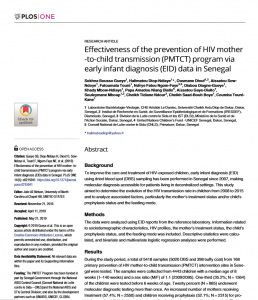
Background
To improve the care and treatment of HIV-exposed children, early infant diagnosis (EID) using dried blood spot (DBS) sampling has been performed in Senegal since 2007, making molecular diagnosis accessible for patients living in decentralized settings. This study aimed to determine the evolution of the HIV transmission rate in children from 2008 to 2015 and to analyze associated factors, particularly the mother’s treatment status and/or child’s prophylaxis status and the feeding mode.
Methods
The data were analyzed using EID reports from the reference laboratory. Information related to sociodemographic characteristics, HIV profiles, the mother’s treatment status, the child’s prophylaxis status, and the feeding mode was included. Descriptive statistics were calculated, and bivariate and multivariate logistic regression analyses were performed.
Results
During the study period, a total of 5,418 samples (5,020 DBS and 398 buffy coat) from 168 primary prevention of HIV mother-to-child transmission (PMTCT) intervention sites in Senegal were tested. The samples were collected from 4,443 children with a median age of 8 weeks (1–140 weeks) and a sex ratio (M/F) of 1.1 (2,309/2,095). One-third (35.2%; N = 1564) of the children were tested before 6 weeks of age. Twenty percent (N = 885) underwent molecular diagnostic testing more than once. An increased number of mothers receiving treatment (57.4%; N = 2550) and children receiving prophylaxis (52.1%; N = 2315) for protection against HIV infection during breastfeeding was found over the study period. The transmission rate decreased from 14.8% (95% confidence interval (CI): 11.4–18.3) in 2008 to 4.1% (95% CI: 2.5–7.5) in 2015 (p < 0.001). However, multivariate logistic regression analysis revealed that independent predictors of HIV mother-to-child transmission included lack of mother’s treatment (adjusted odd ratio (aOR) = 3.8, 95% CI: 1.9–7.7; p˂0.001), lack of child’s prophylaxis (aOR = 7.8, 95% CI: 1.7–35.7; p = 0.009), infant age at diagnosis (aOR = 2.2, 95% CI: 1.1–4.3 for ≤6 weeks versus 12–24 weeks; p = 0.025) and protective effect of breastfeeding on ART against formula feeding (aOR = 0.4, 95% CI: 0.2, 0.7; p = 0.005).
Conclusion
This study demonstrates the effectiveness of PMTCT interventions in Senegal but indicates also that increased efforts should be continued to reduce the MTCT rate to less than 2%.